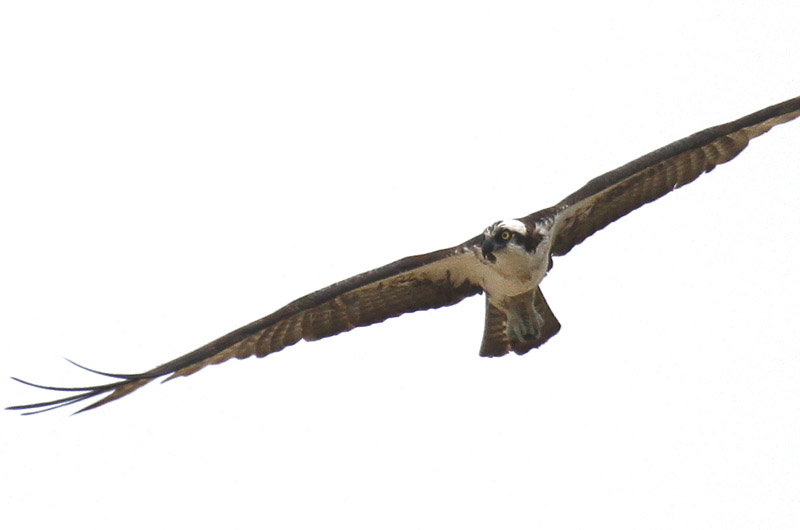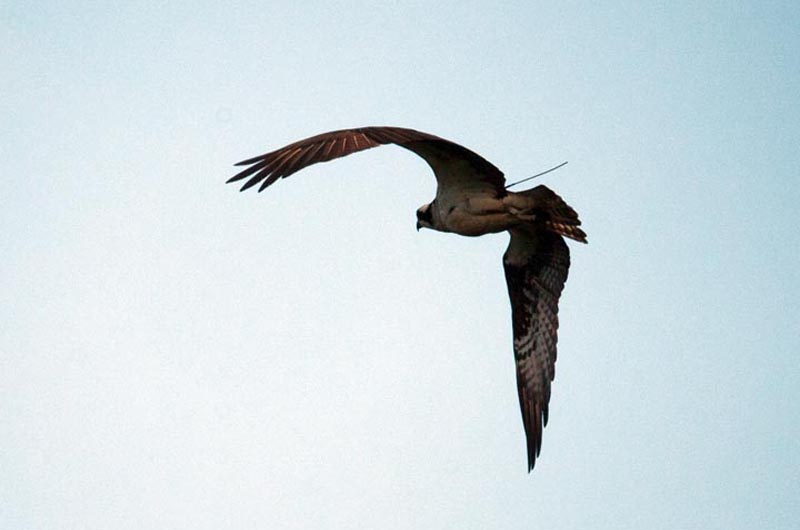Ospreys have departed the Island along with the summer crowds, and most of the migratory birds are now settling into their winter homes thousands of miles away. But back on the Island and elsewhere, osprey trackers are assessing the raptors’ breeding season as a mix of good and bad news. It’s all part of natural fluctuations in the now-robust, closely-observed Vineyard osprey population, scientists said.
There was a record number of breeding ospreys this year, with 87 breeding pairs Island wide, volunteer osprey census-taker Dick Jennings said. In less positive news, 34 of those pairs failed, meaning their nests did not fledge any chicks.
“When I look back at the weather conditions, we had a couple of really severe rainstorms, and I think that contributed to the nest failures,” Mr. Jennings said by phone Monday. If the eggs get wet they can be non-viable, he said, and if a rainstorm comes at hatching time and a parent osprey is unable to keep the chicks out of the elements, they might not make it.

The fish-eating hawks and their nests perched on special osprey poles are now an iconic Vineyard scene and part of a success story. In 1970 there were just two breeding pairs of osprey on the Island, their numbers reduced by use of the chemical dichlorodiphenyltrichloroethane (DDT) and their habit of nesting on (and being knocked off of) utility poles.
Local naturalist Augustus (Gus) Ben David 2nd and other Vineyarders led an initiative to introduce osprey poles as safer nesting sites, and DDT was eventually banned. The number of breeding osprey has set records over the last few years.
The birds also have devoted monitors, from Mr. Ben David, who not only keeps an eye on the population but is known to serve as a surrogate osprey father, to osprey researcher Rob Bierregaard and volunteers like Mr. Jennings. The osprey watchers keep careful track of the Vineyard population from the time they arrive on the Island in the spring and throughout their breeding season until they head south by the end of October.
Mr. Jennings first checks on each of the Island’s 174 potential nesting sites with binoculars and a spotting scope in early May, when ospreys begin setting up their outdoor nurseries. West Tisbury is the Island’s osprey hot spot with 18 nests, followed by Chappaquiddick with 13.
There are a few other volunteers — and more are always welcome, Mr. Jennings said. This year he regularly checked up on 56 osprey pairs. Data has been kept on all the nests since 1998, and Mr. Jennings has pitched in for the last 10 years.

Mr. Bierregaard, a Drexel University research associate, said that in the last 18 years, the average failure rate for osprey nests is 26 per cent. This year’s failure rate of 39 per cent is among the highest, though in 2005 bad weather contributed to a 57 per cent nest failure rate.
But the population is still considered healthy. “It’s hard to imagine it being better,” Mr. Bierregaard said.
This year about 85 young ospreys headed south from the Vineyard for their first migration, a perilous trip that includes threats from eagles, great-horned owls, the weather and people. Some birds are shot in South America, Mr. Jennings said.
Several birds from the Northeast have been equipped with backpack-like transmitters so they can be tracked during their journeys south. Maps of where the osprey go and other information can be viewed at ospreytrax.com.
The ospreys being followed include Belle, who was tagged as a juvenile in 2010 at Lake Tashmoo. Belle (who might turn out to be Beau, Mr. Bierregaard said, as uncertainty lingers about her/his gender), settles down every year on the southern edge of the Amazon forest near the Rio Medeira, 4,600 miles away from the Vineyard.
Snowy, a female (once thought to be a male, osprey gender is a tricky thing) trapped and tagged on Chappaquiddick, “is snuggled down in her Cuban hideout,” Mr. Bierregaard said.
While most osprey head back to the same winter spot year after year, Snowy has two winter homes. She spent her first extended migration in Venezuela before migrating north, stopping for an interlude at Laguna de Leche, or Milk Lagoon, a large lake in Cuba named for limestone sediment that gives the lake a milky look. She eventually came back to the Cape and the Vineyard. The next winter Snowy hunkered down at Laguna de Leche for the whole winter, and then the next year she spent the winter back in Venezuela. This year she went right to Cuba and is still there, back at her favorite lake.
“I’m pretty sure this year she’s going to skip the cross-Caribbean migration,” Mr. Bierregaard said.
Snowy and Belle, both under five years old, have yet to breed, though Mr. Bierregaard said he hopes next year might be the year. When the Vineyard population was struggling it was a “buyer’s market,” Mr. Bierregaard said, with any osprey of breeding age able to breed and few territorial problems. It can be harder for the birds to nest with a larger, denser population, and sometimes they have to wait longer.
Mr. Ben David said the larger population can also lead to greater nest failure.
“As the population increases you get more into specific strife among [the ospreys],” he said. “If you have a number of early nest failures, then those birds will go around and visit other nests still all charged up. They’ll harass other nesters, which increases mortality.”
Nest failure is normal, he added, and can be attributed to a variety of factors. He echoed Mr. Jennings in saying that bad weather can cause high mortality, and added that food availability also plays a part. “It’s all just nature’s dynamics, and you can’t always put your finger on exactly one thing,” he said.
Mr. Ben David successfully fledged some ospreys this year. Three young osprey found out of their nests were brought to the naturalist.
“Sometimes that does give them a second chance, unless they are too emaciated,” he said. Taking care of ospreys includes hand-feeding fish to the hungry young birds.
One bird didn’t make it, but Mr. Ben David was able to successfully raise and fledge the other two. “They flew off,” he confirmed.




Comments (4)
Comments
Comment policy »